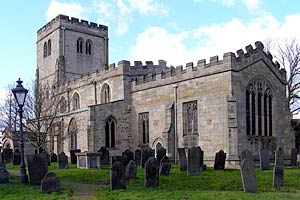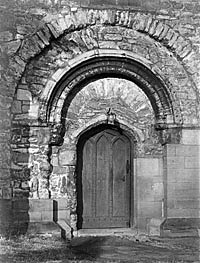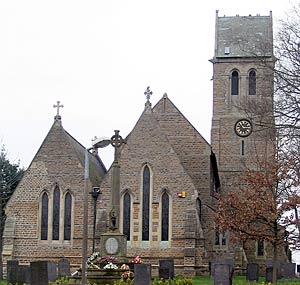< Previous | Contents | Next >
The Old Bridge in the Church Walls
PLUMTREE. With its charming neighbour Normanton, this trim and pleasant village is on the edge of the Wolds, the busy road now passing them by. At one end is the white-walled smithy with its huge black horseshoe; at the other is the church, with part of Nottingham's old Trent Bridge and some Saxon masonry in its walls.

Plumtree church in 2006. © Copyright Ralph Mills and licensed for reuse under this Creative Commons Licence.
The churchyard is a garden, with great trees overhanging the road, and from its gate we have an impressive view of the massive tower; it is the finest part of the church, and has the oldest work, for in its Norman base is the Saxon walling which came to light when the tower was refashioned early this century. Its recessed Norman doorway has roll moulding in the arch resting on capitals which have lost their shafts; outside it there is a simple arch of radiating stones, and within it a later doorway has been built. Two round arches are blocked in its south wall, its buttresses are 13th century, and the top storey is a century later.

Plumtree church: Norman west door, c.1910.
The stone of Old Trent Bridge supplied the fresh material needed in the restoration last century, when the porch was made new, most of the window tracery renewed, and the north aisle given a new arcade. The south arcade comes from the close of the 13th century. The nave has a 15th century clerestory, and is adorned with four crude gargoyle heads with hands in the mouths. Three lovely sedilia, their canopies enriched with pinnacles and finials, are much restored.
Though bright now with electricity, the old iron candelabra still hang in their places. There are some old timbers in the flat roofs, which are painted in medieval colours with gold stars. The best effect of the interior is seen from the dim chancel, the light walls contrasting with the dark wood, and a Norman arch leading to the tower.
Napoleon on Fire
RADCLIFFE-ON-TRENT. It has grown round a road all twists and turns. High up on the ridge of fine cliffs, and of woods overhanging beautiful reaches of the river, is a charming garden where the memory of the men who died for peace is kept green by the fragrance of flowers, the beauty of trees, and the song of birds. It was the gift of the father of one of them, and his own ashes have been scattered here.

Radcliffe-on-Trent church in 2004.
The roomy church, with many arches and a saddleback tower over 100 feet high, is not yet nearly a centenarian. One relic of the old church it replaced is a brass engraved with the figure of a lady wearing a ruff and a long veil as she kneels at a desk; she was Anne Ballard who died in 1626, and her epitaph runs:
Ask how she lived and thou shalt know her end,
She died a saint to God, to the poor a friend.
An inscription to Stephen de Radcliffe of 1245 brings to mind the story of his oak figure, which lay in a recess of the old church. It is said that the villagers, in their great excitement at one of the victories over the French, fetched Stephen from the church, dressed him up to represent Napoleon, and committed him to the flames.
